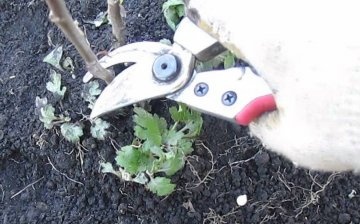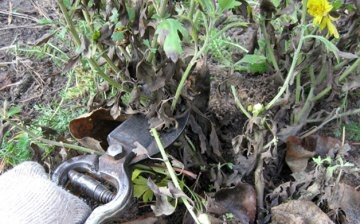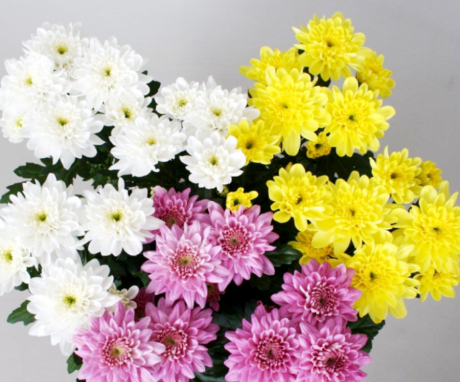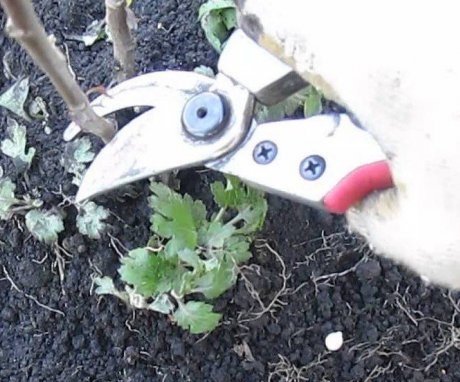Do I need to cut chrysanthemums for the winter and how to do it right
Any grower acquires several varieties of chrysanthemums to decorate patios or flower beds. The plant is unpretentious to care for, but some the nuances of growing are still available. Especially when it comes to preparing the bushes for winter. Whether to prune chrysanthemums for the winter and the rules for pruning are described below.
Do I need to cut chrysanthemums for the winter
Most of the flowers need cropping. This procedure is performed after the end of the flowering period, but long before the onset of frost. Pruning is part of the preparation for wintering the plant. The beauty and health of chrysanthemums depends on how well the work is done.
What does it give
You can cut off excess shoots from the bush, you can do pinching throughout the vegetative period. To prevent the spread of diseases, sanitization is required: diseased leaves, dried inflorescences, and affected branches are removed. But a full cleaning of the chrysanthemum is performed at the end of the season, when the foliage begins to turn yellow intensively.
Autumn pruning contributes to the formation of a beautiful head of the bush, an attractive type of flowers. Removing excess shoots regulates the consumption of valuable substances that are necessary for nutrition. Saving energy and effort to feed sick and extra branches allows the chrysanthemum to saturate the root system with useful microelements.
A pruned plant has a higher chance of survival in winter than an unkempt flower. Shortened bushes can be easily covered with available materials, which prevents the root from freezing at low temperatures. If a chrysanthemum is dug up for the winter, it is much easier to cope with a trimmed bush. In addition, the risks of damage to shoots are reduced to zero.
When to prune
The opinions of experienced florists about the timing of pruning chrysanthemums differ. Some believe that the most favorable period is the end of flowering, others are the beginning of the first frost. Biologists have their own point of view. They tend to be late October - early November.
Reference! Pruning chrysanthemum bushes in the fall is part of a program to prepare the plant for winter. It is carried out in combination with watering, mulching and the introduction of a nutrient mixture.
The intensity of culture development in the next season depends on the quality of the sanitization. Reducing the length of the branches on the plant facilitates the process of covering it for the winter.
Chrysanthemum pruning is done in one of the available intensity options:
- high;
- medium;
- low.
If you do not plan to dig up the plant for storage until spring, choose mainly low and medium pruning.
How to do it right
The work is carried out with a special garden tool with a sharp cutting part. It can be pruning shears or scissors. They are pre-treated with a disinfectant so that the cut points are not infected. Moreover, the cleansing procedure is repeated after each individual plant.
Autumn pruning is done by thinning or shortening.
- Thinning
The side stepsons are completely removed. This method allows you to form a beautiful bush with equal intervals between branches. An improvement in the air-light regime is also achieved, which contributes to normal vegetation.
You need to start thinning the plant from the upper shoots.The largest shoots, all diseased and damaged branches are subject to pruning. The cut is done so that a stump does not form at the base, but also without a deep defeat.
- Shortening
In this version, the side stepchildren are shortened by a certain length. This technology allows you to reduce the parameters of the green part of the flower, to give it a beautiful shape. With such pruning, the growth of stepchildren is activated, the formation of a bush. This method is more suitable for spring work.
Experienced growers advise combining both pruning methods when performing preparatory measures for the winter. First, the plant is pruned at a level of 10-15 cm from the soil surface. After that, it is appropriate to carry out thinning. At the end, it remains to make the shortening of individual shoots.
One of the types of pruning is pinching. It is performed mainly in spring and early summer. Sometimes the need arises when preparing a plant for wintering. For example, top thinning or the use of a mixed method of pruning chrysanthemums cannot do without pinching.
Reference! The purpose of pinching is to remove the tops of the stems and branches to form a beautiful crown of the bush.
Pruning globular chrysanthemums
The beautiful rounded crown of the bush crown is not the fruit of neat pruning, but a genetic feature of the variety. For shaping, you only need to make a single pinch of the shoot after 2-3 pairs of leaves appear on it.
The plant needs pruning only in the fall, when the flowering period is over. In terms of time, this time comes by the end of October - beginning of November. The ground part is cut to a level of 10 cm from the soil surface. This procedure stimulates the growth of root twigs, protects the culture from pests and common diseases.
Karlikov
When growing this variety in the open field, it becomes necessary to dig up a plant for winter storage. Before this, a whole range of measures is carried out with feeding, watering and pruning. Slightly shortening the bush prevents damage to the shoots during storage.
You should not rush to prune chrysanthemums during autumn work. It is necessary to allow the plant to form growth points for the next season. The flowers should dry out. Thus, the culture shows its readiness for wintering.
Reference! Pruning early increases the risk of damaging dormant buds, which will negatively affect the growing season of the chrysanthemum in the next season.
Other stages of preparing chrysanthemums for winter
Preparatory work includes a set of activities, including the following stages.
Autumn watering and feeding
Before the onset of frost, the culture is organized with water-charging irrigation. To do this, each plant is irrigated at the root with settled water (5 l). Drinking plenty of water helps to saturate the tissues of the stem and roots with liquid.
Top dressing is introduced in late September or early October. Nutrient blend replenishes flowering losses. At this stage, it is appropriate to use potassium-phosphorus fertilizers, which strengthen immunity, increase resistance to adverse conditions.
In order to enrich the soil with oxygen, it is recommended to loosen the soil well after watering and cover it with a layer of mulch. Air passages are formed between the lumps of soil, which will exclude root rot.
Treatment against diseases and pests
Sanitary cleaning is carried out throughout the growing season. All damaged and diseased shoots are removed from the bush so that pathogenic microflora does not develop in them.
Common chrysanthemum diseases:
- gray rot;
- powdery mildew;
- speckled mosaic;
- rust;
- septoria;
- withering.
If signs of infection or a virus are detected, the bushes are sprayed with special solutions. Of the most effective means: Bordeaux liquid, copper sulfate with laundry soap, colloidal sulfur.Processing should be carried out not only on diseased bushes, but also on all flowers growing nearby. Prevention is carried out in a similar way.
Reference! A flowerbed of chrysanthemums should be periodically examined to detect diseases at an early stage of development. It is easier to deal with the problem at this stage.
No less dangerous are pests for flowers:
- nematode;
- mite;
- meadow bug;
- aphid;
- worm.
Spraying with the use of special preparations (Actellik, Aktara, Phosphamide, etc.) will help to eliminate the problem.
Digging out
Most of the varieties of chrysanthemums that are intended for cutting need to be dug up in the fall. They do the same with large-colored varieties. Excavation from the ground is done before the onset of stable frosts.
Pruned bushes can be transplanted into large containers and placed in a cool room. Biologists say that this option is not suitable for some varieties of chrysanthemums, which are demanding on the dormant period.
Transfer
It is necessary to change the place of growth of chrysanthemums for selected varieties, which are characterized by thermophilicity. The change in environment benefits cut chrysanthemums, dwarf varieties, globular, large-flowered and European hybrids. Young shoots planted late in open ground also need transplantation. Without gaining sufficient root growth, they have a small chance of survival in the winter.
Transplant work is planned for the fall. After sanitizing and pruning, the heat-loving chrysanthemums are carefully removed with an earthen lump. Next, the plants are placed in boxes made of wooden planks, half filled with sawdust. The container is installed for storage in a cellar or basement. You can do differently with a dug out shoot by planting it in a wide pot filled with soil mixture.
Shelter
After removing excess shoots, the bush is huddled, leveling the soil so that there are no pits. Moisture can collect in the grooves, the abundance of which provokes decay of the roots. Correct hilling involves hiding under a layer of earth the places where the shoots are cut. Next, dry foliage or sawdust is laid. Spruce branches are also suitable for these purposes.
Reference! You need to cover the flowers after the onset of cold weather. In a warm environment, pathogenic microflora actively develops, which leads to the death of the plant.
So that the warm flooring on the soil is not blown away by the wind, a sheet of slate or metal should be put on top of the shelter. To create ventilation, it is recommended to spread sheet material on small elevations made of bricks. The decking prevents large amounts of rainfall from entering the chrysanthemum shelter.
Features of preparing chrysanthemums for winter, depending on the variety
When pruning bushes, varietal characteristics are taken into account. In this case, it means whether the culture is large-flowered or small-flowered, single-stemmed or multi-stemmed. The nature of the cut of the shoots affects the further development of the culture, in particular with regard to the preparation of the mother bush for reproduction in the spring by cuttings.
Reference! How the pruning was carried out determines the further scope of work on creating a shelter for the winter or digging up a plant for storage in the basement.
Taking into account the variety, the pruning intensity also changes. After processing, the length of the shoots remains from 10 to 25 cm. More often the parameters correspond to the characteristic features of a certain variety of chrysanthemums: the higher the growth, the lower the cut.
Depending on the region
Regardless of the region of cultivation, the preparation of chrysanthemums for winter is carried out according to the same rules. The exception is the timing of the work and the characteristics of the varieties.
- In a harsh climate (Siberia, Ural), all varieties of crops are dug up in the fall for storage in a basement or other cool place. But most of the flowers are still grown in greenhouses.
- In the middle lane (Moscow, Tula, Kostroma and other regions), frost-resistant varieties are left in the ground under cover. Heat-loving chrysanthemums are dug up in the fall.
- In the southern part of Russia (Krasnodar Territory, Rostov Region, the Republic of Crimea and other regions), chrysanthemums mostly remain overwintering in the soil.
When growing chrysanthemums in pots, pruning is not tied to a specific time of the year.
Video about pruning and sheltering chrysanthemums for the winter:












We have chrysanthemums blooming for a very long time, until the snow falls. In terms of time, this is approximately the end of November - the beginning of December. Therefore, we perform pruning in the same period. Winters are warm and chrysanthemums do not freeze out.